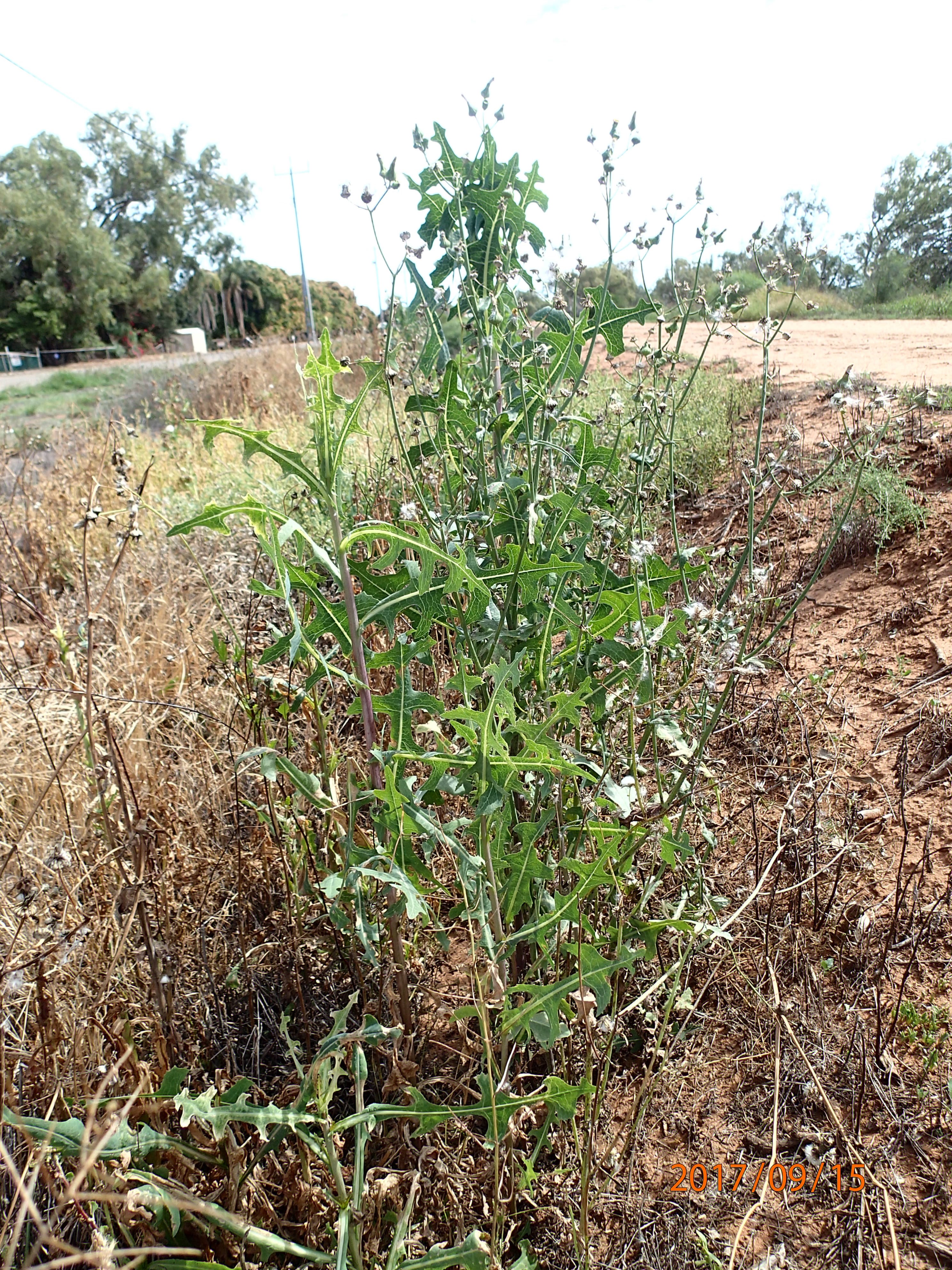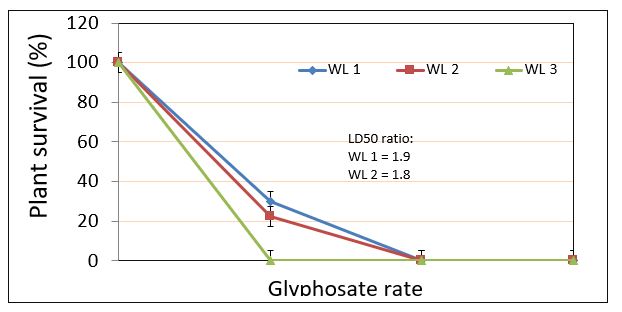Willow-leaved lettuce (Lactuca saligna) has developed resistance to glyphosate in Western Australia
Author: Abul Hashem, Mohammad Amjad and Catherine Borger, Department of Primary Industries and Regional Development, Northam | Date: 26 Feb 2018
Key Messages
- Two populations of willow-leaved lettuce collected from an irrigated horticultural property in the Gascoyne Region of Western Australia (WA) have tested resistant to glyphosate.
- This first report of willow-leaved lettuce resistance to glyphosate in the world is of immediate concern to irrigated agriculture but is also relevant to the whole grains industry. It shows that no sector of agriculture is immune from glyphosate resistance if glyphosate is the main weed control strategy.
- Growers must adopt integrated weed management (IWM), including alternative non-selective herbicides, to minimise the risk of glyphosate resistance development in weeds.
Aims
Willow-leaved lettuce (Lactuca saligna), also known as wild lettuce, is a close relative of prickly lettuce (Lactuca serriola), a common weed of roadsides, wastelands and occasionally in crop fields in WA during spring and early summer.
Prickly lettuce is a major weed of winter crops and summer fallows in northern Victoria and southern NSW. Compared to prickly lettuce, willow-leaved lettuce is not commonly found in the grain growing areas of WA (Hussey et. al. 2007). However, it has been recorded in the Avon wheatbelt, Jarrah Forest, Mallee, Pilbara, Swan Coastal Plain and many WA local government council areas including Armadale, Brookton, East Pilbara, Gnowangerup, Harvey, Karratha, Kondinin, Mandurah, Melville, Merredin, Perth, South Perth, Stirling, and Victoria Park of WA (FloraBase 2017).
Prickly lettuce has developed resistance to Acetolactate synthase (ALS) herbicides in the USA (Mallory-Smith 1990) and to ALS and glyphosate in in the eastern states of Australia (Preston 2017). Globally, no resistance in any populations of willow-leaved lettuce has previously been reported.
A grower reported failure of glyphosate to control willow-leaved lettuce in an irrigated vegetable field in the Gascoyne, Western Australia (WA) in the spring of 2016. A study was undertaken in 2016/2017 to test glyphosate resistance in three populations of willow-leaved lettuce from the property of the affected grower and close-by neighbouring properties.
Methods
Mature seed of three populations of willow-leaved lettuce were collected in December of 2016 from irrigated horticultural properties in the Gascoyne, WA. Populations WL1 (24°50'30.2099", 113°44'01.8718") and WL2 (24°50'30.5230", 113°44'00.7394) were collected from paddocks where glyphosate was sprayed to control this weed in vegetable crops in 2016. Population WL3 was collected from a nearby unsprayed wasteland.
The seed was stored in a non-air-conditioned glasshouse at Northam from January to February. Plastic pots (1.8 L) were filled with 50% sand and 50% commercial potting mix in March 2017, and 30-50 seeds were sown at a depth of 1-2 mm. Seedlings emerged about 8-10 days after sowing. Emergence was 60-70%, but natural mortality of seedlings thinned the populations to 4-6 plants per pot.
At the 3-4 leaf stage, seedlings were sprayed with four rates of glyphosate (Roundup PowerMAX®, glyphosate 540g/L) to enable detection of resistant (R) to susceptible (S) populations. Since seedlings of this warm season weed species were not growing well in the air-conditioned glasshouse in June 2017, the pots were transferred to a growth chamber (30OC with 55% humidity) one week after spraying.

Figure 1: Mature plants of willow-leaved lettuce growing in an unsprayed area in the Gascoyne irrigated region of Western Australia (Photo by John Stretch)
Plant survival was assessed four weeks after spraying. A plant was assessed as surviving if it was not affected by herbicide or affected by herbicide but actively regrowing with visible green shoots and new leaves. A plant was assessed as dead if it was visibly senesced with no regrowth, or if part of shoot base was green but the central growing point was completely dead.
Design and analysis
The experiment was conducted in a completely randomised design replicated three times. Plant survival was subjected to ANOVA (GENSTAT 18th Edition). The LD50 ratio of the Resistant (R) to susceptible (S) populations was estimated by probit analysis (GENSTAT 18th Edition).
Results
The results suggest that the willow-leaved lettuce populations WL1 and WL2 tolerated higher rates of glyphosate than WL3 where the population was rarely treated with glyphosate. Probit analysis showed that the LD50 ratio was 1.9 for WL1 and 1.8 for WL2 compared to WL3 (Figure 1). These results further confirmed that WL1 and WL2 are about two times more resistant than the susceptible population WL3.These two populations (WL1 and WL2) have evolved resistance to glyphosate presumably due to continuous use of glyphosate as knockdown herbicide without using any alternative non-selective herbicide molecule from a different mode of action or a non-chemical knockdown option.
Figure 2: Percent plant survival of three populations of willow-leaved lettuce (WL1, WL2 and WL3) collected from the WA Gascoyne, following application of glyphosate at the 3-4 leaf stage. Error bars represent the standard error of the mean of three replications.
Figure 3: Willow-leaved lettuce (Lactuca saligna) plants of population WL2 treated with increasing rates of glyphosate left to right.
Conclusions
This is the first report of glyphosate resistance in willow-leaved lettuce internationally, and the seventh glyphosate resistant broadleaf weed species to be confirmed in Australia. The discovery is of immediate concern to the irrigated agricultural industry. This species is bisexual (Mejías 1994) (both male and female parts are present on the same flower), so resistance is more likely to spread through seed dispersal rather than by cross pollination.
The industry will have to consider the extent of seed dispersal and persistence of the seedbank in developing management plans for the resistant populations. The findings of this paper are also relevant to other agricultural sectors and the grains industry as this species has the potential to move into cropping paddocks due to wind dispersed seed.
The level of resistance in these populations and the number of resistant populations in irrigated horticulture regions will increase further if growers continue to use glyphosate every year, before or after every crop. To manage this weed and delay further development of resistance to glyphosate in willow-leaved lettuce and other weed species, the growers must apply the principles of integrated weed management (IWM).
An IWM program may include using improving spray application techniques, using a double knock with a second herbicide from a different mode of action or cultivation, using robust tank-mixes with two herbicides effective against the target species, and using other non-chemical weed control options. More information on glyphosate resistance can be found on the Australian Glyphosate Sustainability Working Group website.
Caution: Research on unregistered agricultural chemical use
Any research with unregistered agricultural chemicals or of unregistered products reported in this document does not constitute a recommendation for that particular use by the authors or the authors’ organisations.
All agricultural chemical applications must accord with the currently registered label for that particular agricultural chemical, crop, pest and region.
References
Mallory-Smith CA, Thill DC and Dial MC (1990) Identification of sulfonylurea herbicide-resistant prickly lettuce (Lactuca serriola). Weed Technology, 4(1): 163-168.
Preston C (2017) Australian Glyphosate Sustainability Working Group, Glyphosate Resistance accessed on 11 August 2017.
FloraBase - the Western Australian Flora. WA. FloraBase (Accessed on 25 August 2017)
Hussey BMJ, Keighery GJ, Dodd J, Lloyd SG, and Cousens RD (2007) Western Weeds; a guide to weeds in Western Australia (second edition), The Weeds Society of Western Australian (Inc.), Perth.
Mejías JA (1994) Self-fertility and associated flower head traits in the Iberian taxa of Lactuca and related genera (Asteraceae: Lactuceae). Pl. Syst. Evol. 191:147-160 (1994).
Acknowledgments
The research undertaken as part of this Emerging summer weeds project (UA00149) is made possible by the significant contributions of growers through both trial cooperation and the support of the GRDC; the authors would like to thank them for their continued support.
Thanks are due to Nerys Wilkins and Dave Nicholson, Technical Officers of the Department of Primary Industry and Regional Development (DPIRD) at Northam for all technical assistance in undertaking the herbicide resistance testing.
We are very grateful to John Stretch and Damian Priest of DPIRD Office for collecting the seed of willow-leaved lettuce.
We are also thankful to Dr Chris Preston, University of Adelaide for research collaboration.
Special thanks are due to Andrew Storrie for reviewing the paper.
GRDC Project Number: UA00149
GRDC Project Code: UA00149,
Was this page helpful?
YOUR FEEDBACK


